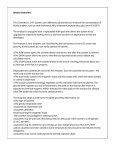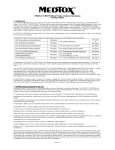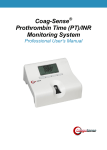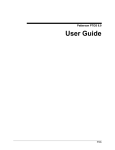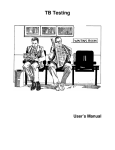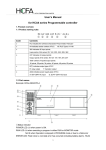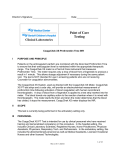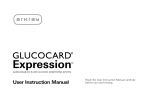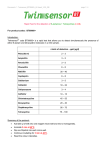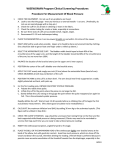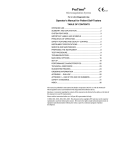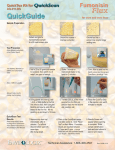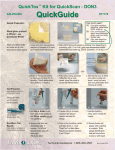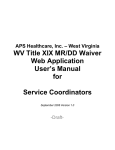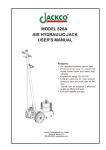Download CHO-03-019 LDXQRG_1
Transcript
CHO-03-019 LDXQRG_1 4/10/03 1:07 PM Page 1 Introduction The Cholestech LDX is a small, portable analyzer and test cassette system. It is easy to use, and gives fast and reliable results. To run a test, just add a sample to the cassette and place it in the Analyzer. In a few minutes, the results will appear on the screen. The Cholestech LDX System is for in vitro diagnostic use only. This guide contains information intended to familiarize and instruct the user in the proper use and care of the Cholestech LDX System. Cholestech Corporation and our distributors will provide every customer with technical support and training needed to properly use the Cholestech LDX System. Cholestech maintains a staff of qualified Technical Service Representatives who are available 24 hours a day, 7 days a week. Quick Reference Guide For ordering information or other customer service–related questions, contact Cholestech Customer Service from 6:00 AM to 5:00 PM Pacific time, Monday through Friday. Please feel free to contact us at: System Components Cholestech LDX Analyzer Printer Results from each cassette will print out on the Cholestech Thermal Printer. One or two labels may be printed. Analyzer Display Screen ‘Stop’ Button Cholestech Corporation 3347 Investment Blvd. Hayward, CA 94545 U.S.A. Tel 800 733.0404 Fax 510 732.7227 www.cholestech.com ‘Data’ Button Test Cassette Cassette Drawer Blood from a fingerstick sample is placed into a single-use, disposable cassette. Multiple test results are available in 5 minutes. ‘Run’ Button Capillary Tubes/Plungers Lancets Blood from a fingerstick sample is collected into a capillary tube with heparin anticoagulant. The black plunger dispenses the sample into the sample well in the cassette. PLEASE NOTE: Even though the Cholestech LDX is a “CLIA-waived” test system, each laboratory or testing site using the Cholestech LDX must have a CLIA Certificate of Waiver. To obtain a Certificate of Waiver, call your state department of health or Cholestech for an application. Failure to operate the Cholestech LDX in accordance with the manufacturer’s instructions will void the waived status. The tests will then be considered highly complex. A single-use lancet is used to perform a fingerstick to collect a blood sample for testing on the Cholestech LDX. 403 12047 Cholestech LDX is a registered trademark of Cholestech Corporation. MiniPet is a trademark of Tri-Continent Scientific, Inc. © 2002 Cholestech Corporation. 403 12047 Rev. C 3347 Investment Blvd. Hayward, CA 94545 U.S.A. Tel 800 733.0404 Fax 510 732.7227 www.cholestech.com 403 12047 Rev. C CHO-03-019 LDXQRG_1 4/10/03 1:07 PM Page 2 Setup Test Procedure Take the time to examine and familiarize yourself with the contents of the Cholestech LDX System. the Cholestech LDX 1 Connecting to the Printer A Before starting to test, press and hold STOP to enter the Configuration Menu and select options for language, units, sample type, printer, risk assessment, date, and time. A B Plug the power supply A into the Cholestech LDX and the wall or power strip. Insert the end of the white printer cable B , labeled “To Cholestech LDX”, into the Analyzer. The DATA button allows you to select choices for each of the menu items in the Configuration Menu. The RUN button enters your choices and advances you to the next menu item. 3 Optics Check 4 Running Controls Run the Optics Check Cassette Cholestech Level 1 and 2 Controls Press the RUN button. The drawer will open. Place the Optics Check Cassette into the cassette drawer. Press the RUN button again to close the drawer. Controls must be run following manufacturer’s recommendations. Controls must be at room temperature before testing. Verify that the lot number on the control vial and the assay sheet are the same. Mix each vial by gently inverting 7–8 times immediately before use. Store controls in the refrigerator when not in use. Record Results Check to see that the four numbers are within the acceptable range printed Optics Check Results on the Optics Check Cassette. Record the results on the Optics Check Log. If the numbers are outside the range, the Analyzer will be temporarily disabled until another optics check is run that falls within range. The Optics Check Cassette is used to check the optical system of the Analyzer. Run the Optics Check Cassette: once each day before patient samples are tested and after the Cholestech LDX has been moved or serviced. Perform a Fingerstick 2 Collect the Sample 3 Dispense the Sample 4 Open the Drawer 2 Configuration Menu B Plug the printer power supply A into the printer and the wall or power strip. Connect the end of the printer cable B , labeled “To Printer” , to the printer. 1 Testing QC Material Use the MiniPet™ Pipette and tips to measure and dispense the control sample into the cassette. Place the cassette in the drawer immediately and press RUN. Record results on the Quality Control Log. Results must be within established ranges before patient samples can be tested. After cleaning the selected site with alcohol and drying it thoroughly, firmly prick the site with a lancet. Gently squeeze the finger to obtain a large drop of blood. Wipe off the first large drop of blood. 5 Insert the Cassette Squeeze the finger gently again until a large drop of blood forms. Hold the capillary tube horizontally by the end with the plunger. Touch it to the drop of blood without touching the skin. Fill the capillary tube within 10 seconds. Do not allow any bubbles to enter the capillary tube. 6 Immediately place the cassette into the Analyzer drawer with the black reaction bar toward the Analyzer and the brown magnetic stripe on the right. Begin the Test Press RUN. The drawer will close. Test run time is 5 minutes. When the test is finished, the Analyzer will beep and the drawer will open. Put everything that touched the blood sample into a biohazardous waste container. Place the end of the capillary tube into the sample well and dispense the sample by pushing down on the plunger. Keep the cassette level after the sample has been applied. 7 View the Results Press the DATA button on the Analyzer to view the calculated results. Press the RUN button on the Analyzer. The cassette drawer will open, and the screen will display: Load cassette and press RUN. 8 Print the Results The results will print when the test is finished. If the Framingham Risk is ON, press the DATA button twice and push RUN to run the risk assessment, or STOP to print the results. This reference guide provides a brief summary of the testing procedure. For more information, see the test cassette product inserts, the Cholestech LDX System User Manual, or the Cholestech LDX System Training Video. FAQ Frequently asked questions about the use of the Cholestech LDX How do I get a CLIA Certificate of Waiver? Even though the Cholestech LDX is a “CLIA-waived” test system, each laboratory or testing site using the Cholestech LDX must have a CLIA Certificate of Waiver before starting testing. To obtain a Certificate of Waiver, call your state department of health or Cholestech Technical Service (800-733-0404) for an application (form HCFA-116). Cholestech Technical Service can give you the phone number of your state department of health and assist you in filling out the application. Remember: The Cholestech LDX System is only waived for fingerstick or venous whole blood. How often do I have to run the controls? If you are testing under CLIA-waived status, you must follow the manufacturer’s recommendations for running controls. Cholestech recommends that you run controls: • With each new shipment of cassettes (even if cassettes are from the same lot previously received). • With each new lot of cassettes. • As otherwise required by your laboratory’s standard quality control procedures. • If you are not running the Cholestech LDX under CLIA-waived status, or if your local or state regulations require more frequent testing of quality control material, then quality control must be performed in compliance with those regulations. How should I store my cassettes? When stored refrigerated at 36–46˚F (2–8˚C), the cassettes are stable until the expiration date printed on the cassette pouch and box. Cassettes can be stored at room temperature for 30 days. Do not use a cassette past the expiration date. Do not return cassettes to the refrigerator once they have been stored at room temperature.


